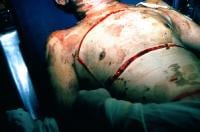Two cases are described in Pre-hospital Emergency Care of severely burned patients who were impossible to adequately ventilate after tracheal intubation until they underwent escharotomy by a pre-hospital physician.
The review that follows reminds us of some intersting escharotomy facts:
- circumferential extremity burns can cause limb ischaemia
- abdominal burns can cause elevated intra-abdominal pressure and ischemic bowel
- neck burns can cause tracheal and jugular venous compression
- chest burns can cause respiratory compromise
- one previous study showed that chest and abdominal escharotomies significantly decreased intra-abdominal pressure, retention of carbon dioxide, and central venous and inferior vena caval pressures while significantly increasing serum oxygen concentration and systolic blood pressure.
- escharotomies may be performed on multiple body parts, including the extremities, the digits, the chest, the abdomen, the neck, and the penis
- neck escharotomy is a relatively simple procedure that involves an incision of the skin eschar longitudinally in the anterior midline from the chin to the sternal notch
- although different ways of doing chest escharotomies have been described, in the two reported cases in this article the procedure only involved longitudinal incisions, with good immediate effect.

Of note, neither of the physicians concerned had seen or done an escharotomy before. I’m adding this to my list of life-saving surgical interventions that are technically straightforward to perform, cannot always wait for another specialist to do, and happen too rarely to train for in the traditional way (ie being taught on a patient under supervision prior to the first time you do one).
Out-of-hospital chest escharotomy: a case series and procedure review
Prehosp Emerg Care. 2010 Jul-Sep;14(3):349-54
